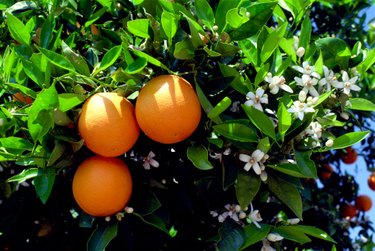
Black spots on a citrus tree may be symptomatic of sooty mold, a minor problem that can be easily remedied with soapy water or insecticide, according to Texas A&M University's AgriLife Extension.
Causes
Video of the Day
Spread by insects such as scales, whiteflies, aphids and mealybugs with piercing mouth parts, sooty mold occurs when the insect deposits honeydew excrement onto the leaves of the citrus tree. Sooty mold is not usually seen in dry, desert climates.
Video of the Day
Symptoms
Sooty mold appears as a black, spotted fungal growth on leaves, fruit, twigs and branches of citrus trees. Other symptoms can include a delay in the citrus fruit's coloring, spirals of eggs on the undersides of leaves or the presence of small black insects.
Control
To remove sooty mold from and prevent further outbreak, the Arizona Cooperative Extension recommends using mild soap to wash away the mold, as well as removing the insect population. Horticultural oil and insecticide can be used to eradicate the insect population.